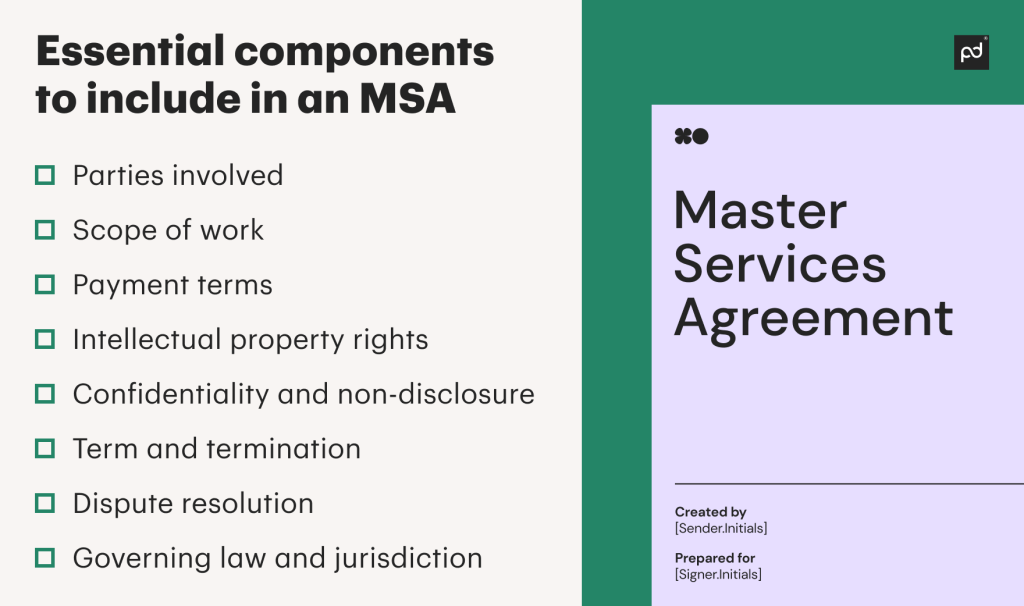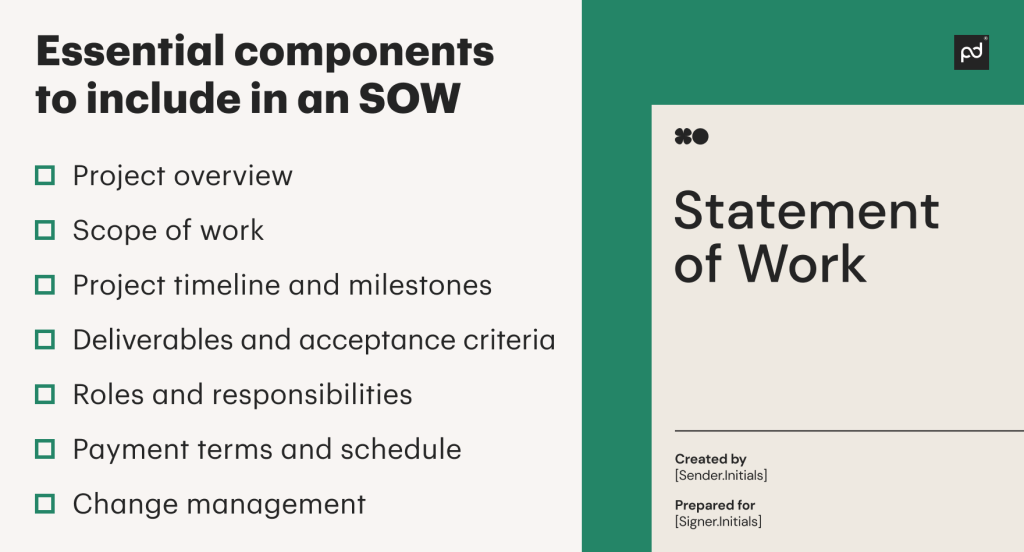Master services agreements and statements of work are both crucial documents but there are key differences between them.
In this article, we’ll examine what sets the two apart.
We’ll provide insight into their purposes, advantages, and how to navigate the interplay between them.
Whether you’re an employment leader, operations manager, or simply involved in contract negotiations, this guide will equip you with the knowledge to make informed decisions and optimize your contractual engagements.
What is a master services agreement (MSA)?
So, to start, what is a master service agreement?
A master services agreement is a crucial contractual arrangement that establishes the overarching terms and conditions between two parties (typically a service provider and a client) for a wide range of ongoing services.
It acts as a framework to outline both parties’ general obligations, rights, and responsibilities throughout their business relationship.
An MSA is essentially a foundational document, providing a solid legal structure for future engagements between the parties.
It covers aspects such as the scope of work, project timelines, payment terms, intellectual property rights, confidentiality provisions, termination conditions, and dispute resolution mechanisms.
By establishing these key elements upfront, an MSA streamlines the process of entering into subsequent agreements, such as statements of work (SOWs) or purchase orders.
Advantages of signing a master services agreement (MSA)
Efficient contracting
By laying down a comprehensive framework, an MSA streamlines the contracting process, saving valuable time and effort.
This eliminates the need for repetitive negotiations or individual contracts for each project or engagement, thus enabling quicker and more efficient collaboration.
Clarity and consistency
An MSA fosters transparency and uniformity in business dealings.
By clearly defining the terms and conditions applicable to all projects or services, it ensures a shared understanding of rights and obligations.
This reduces the likelihood of misunderstandings or disputes that could harm workflows.
Flexibility and scalability
The flexibility of an MSA allows for its easy adaptation to various projects and services over time.
It provides a scalable framework that accommodates changing needs, facilitating the inclusion or modification of project-specific details through statements of work (SOWs) while maintaining the overarching agreement.
Risk management
A well-drafted MSA plays a vital role in mitigating legal risks. It addresses critical aspects such as project scope, timelines, and payment terms.
This proactive approach minimizes potential conflicts and safeguards the interests of both parties.
Cost savings
Through its upfront establishment of terms and conditions, an MSA reduces the need for extensive negotiations and revisions for each project or engagement.
This results in cost savings related to legal fees and administrative overheads, benefiting both the service provider and the client.
On the whole, a master services agreement (MSA) serves as a comprehensive business contract that sets the stage for a successful relationship between a service provider and a client.
With its efficient contracting process, clarity and consistency, and cost savings, it’s an essential tool for parties engaged in ongoing services.
MSA agreement template
When it comes to establishing a solid foundation for ongoing services, master service agreements (MSAs) are indispensable.
However, creating one from scratch can be a daunting task — which is why using templates can be a game-changer.
In this section, we delve into the essential components to include in an MSA agreement, providing a comprehensive guide to help employment leaders develop effective MSAs that ensure clarity, compliance, and successful business relationships.

1. Parties involved
Clearly identify the parties entering into the MSA.
Include their legal names, addresses, and contact information to establish a clear understanding of who the agreement encompasses.
2. Scope of work
Define the scope of the work in detail, outlining the specific services to be provided under the MSA.
Be explicit about deliverables, timelines, milestones, and any relevant performance metrics to set clear expectations.
3. Payment terms
Specify payment terms, including pricing structures, billing cycles, and any applicable fees.
Detail how and when payments should be made, ensuring both parties are in agreement on the financial aspects of the engagement.
4. Intellectual property rights
Address intellectual property ownership and rights.
Clearly outline who will retain ownership of any existing intellectual property and how new intellectual property will be handled, including licensing, usage rights, and confidentiality obligations.
5. Confidentiality and non-disclosure
Include provisions that protect the confidentiality of sensitive information shared during the engagement.
Clearly define what constitutes confidential information and outline obligations regarding its use, disclosure, and protection.
6. Term and termination
Specify the duration of the agreement and the conditions for termination.
Outline the notice periods, termination rights, and any applicable consequences or remedies in case of termination.
7. Dispute resolution
Include a section on dispute resolution mechanisms, such as arbitration or mediation, to provide a structured process for resolving conflicts that may arise during the engagement.
Clearly outline the steps to be followed and the governing law for dispute resolution.
8. Governing law and jurisdiction
Specify the governing law that will apply to the agreement and the jurisdiction where any legal disputes will be resolved.
This ensures that both parties are aware of the legal framework governing the MSA and provides clarity in case of legal action.
Utilizing an agreement template can significantly simplify the process of creating a comprehensive and effective MSA.
By following the checklist above, anyone can establish a strong contractual foundation that promotes clarity, compliance, and successful business relationships.
Remember, an MSA agreement template is a starting point that should be customized to fit your unique business requirements, ensuring all parties are aligned and protected throughout the engagement.
What is a statement of work (SOW)?
Statements of work (SOWs) are formal documents that define the detailed scope, objectives, and deliverables of a project or engagement.
They serve as a roadmap, guiding clients and service providers in understanding project requirements and expectations.
Legally speaking, an SOW acts as a contractual agreement, ensuring alignment and clarity between the parties involved.
Advantages of signing a statement of work (SOW)
Clarity
A well-crafted SOW clearly defines project objectives, deliverables, and expectations, leaving no room for ambiguity.
It ensures all stakeholders have a shared understanding of the project scope and desired outcomes.
Scope management
By explicitly outlining project boundaries and deliverables, an SOW helps manage scope creep.
It provides a reference point to assess any proposed changes and ensures the project remains focused on its original goals.
Risk mitigation
An SOW serves as a risk management tool, identifying potential risks and outlining strategies for mitigation.
It enables proactive planning, setting the stage for successful risk management throughout the project lifecycle.
Accountability
With a well-defined SOW, both clients and service providers have clear accountability.
It establishes responsibilities, timelines, and performance expectations, enabling effective project oversight and ensuring each party fulfills its obligations.
Contractual protection
An SOW provides legal protection by defining the terms and conditions of the project engagement.
It helps resolve disputes that may arise, as it serves as a reference point for evaluating performance and compliance.
Collaboration and communication
The SOW facilitates collaboration and effective communication among project stakeholders.
As a common reference document, everyone can easily stay on the same page, promoting smooth coordination and collaboration.
To sum it up, a statement of work (SOW) acts as a guiding light for successful project execution.
With its focus on transparency and accountability, business owners can use it to drive positive project outcomes.
Embrace the power of a well-crafted SOW to lay the foundation for clarity, alignment, and overall project success.
SOW agreement template
SOW agreements are useful to both service providers and clients, as they avert the possibility of confusion or employment disputes.
However, creating one from scratch can be both time-consuming and complex.
In this section, we provide a comprehensive guide to the core components to include in an SOW agreement.
Employment leaders can use this resource to help develop effective agreements that ensure alignment with their desired project outcomes.

1. Project overview
Begin the SOW agreement with a concise project overview.
This section should provide a high-level summary of the project, including its objectives, purpose, and expected outcomes.
This helps stakeholders grasp the essence of the project and align their understanding.
2. Scope of work
Define the scope of the project in detail.
Outline the specific tasks, activities, and deliverables that need to be completed.
Clearly articulate what’s included in the project and, if applicable, specify what’s excluded to avoid any potential misunderstandings.
3. Project timeline and milestones
Include a timeline that outlines the project’s duration and key milestones.
Break the project down into phases or stages, specifying expected start and end dates for each milestone.
This section helps manage project expectations and provides a roadmap for progress tracking.
4. Deliverables and acceptance criteria
Specify the expected deliverables and their acceptance criteria.
Clearly define the quality standards that need to be met for each deliverable to be considered complete and accepted.
This section ensures that both parties have a shared understanding of the expected outcomes.
5. Roles and responsibilities
Identify the roles and responsibilities of each party involved in the project.
Clearly outline the responsibilities of the client and the service provider, including any specific contributions, approvals, or resources required.
This section promotes accountability and effective collaboration.
6. Payment terms and schedule
Include the payment terms and schedule for the project.
Outline the pricing structure, payment milestones, and any relevant payment terms or conditions.
Be clear about when payments are due and any invoicing or billing processes that need to be followed.
7. Change management
Address how changes to the project scope, timeline, or deliverables will be managed.
Specify the process for requesting and approving changes, including any potential impact on project timelines, costs, or resources.
This section ensures that changes are properly evaluated and managed.
Following a statement of work template can simplify the process of creating a comprehensive and effective agreement.
Be sure to include the key features listed above to ensure transparency and minimize the risk of interruptions to work.
So, what’s the difference between an MSA and SOW?
The main difference between a master service agreement (MSA) and a statement of work (SOW) lies in their scope and purpose.
| MSA | SOW | |
|---|---|---|
| What is its purpose? | An MSA establishes the overall contractual relationship between parties. | In contrast, an SOW is a project-specific document. |
| What does it cover? | It seeks to cover general terms, responsibilities, and legal obligations. | Details the certain scope of work, deliverables, timeline, and pricing. |
While an MSA provides a framework for multiple projects, an SOW focuses on the specifics of a single engagement.
Both documents are essential in governing business relationships, ensuring clarity and alignment between the parties.
How to use master service agreements vs. statements of work
To effectively navigate the relationship between master service agreements (MSAs) and statements of work (SOWs), it’s important to understand their distinct roles and when to utilize each of them.
As we explored, an MSA sets the foundation by establishing overarching responsibilities between the parties.
SOWs, on the other hand, provide project-specific details such as scope, deliverables, timeline, and pricing.
In practice, organizations often use both in conjunction.
An MSA provides consistency across multiple projects, while SOWs address the unique requirements of each engagement.
When initiating a new project, an MSA may already be in place, allowing for the creation of an SOW that references the MSA’s terms.
This combination ensures clarity, efficiency, and streamlined contract management in complex business relationships.
So, whether you’re considering an MSA vs. SOW or leveraging them together, understanding their complementary nature is key to successful contract management.
Which type of agreement do you need?
Determining which type of agreement you need comes down to the specific requirements and desired goals of your business engagement.
- An MSA is suitable when you want to establish a long-term relationship with a service provider and outline general terms and legal obligations.
- On the other hand, if you require a detailed breakdown of a specific project, then an SOW is more appropriate.
The best approach is to be proactive by considering the duration, complexity, and level of detail required.
Then, choose the agreement type that best aligns with your company’s objectives.
Simplify negotiations with the agreement you need
Understanding the distinctions between a master services agreement (MSA) and a statement of work (SOW) empowers businesses to navigate their contractual relationships with clarity and confidence.
By leveraging the appropriate agreement type for each stage of collaboration, organizations can establish a solid foundation and ensure project-specific details are accurately captured.
To streamline the creation and management of these vital documents, utilizing a comprehensive form builder solution like PandaDoc can prove invaluable.
PandaDoc’s user-friendly platform offers customizable templates for both MSAs and SOWs, providing a seamless and efficient process for generating contracts.
Regardless of your company’s goals, PandaDoc’s form builder solution simplifies the creation of professional agreements.
Experience the convenience and effectiveness of PandaDoc’s form builder to optimize your contract workflows and enhance the success of your business engagements.
Get started today with a free 14-day trial.
Disclaimer
PandDoc is not a law firm, or a substitute for an attorney or law firm. This page is not intended to and does not provide legal advice. Should you have legal questions on the validity of e-signatures or digital signatures and the enforceability thereof, please consult with an attorney or law firm. Use of PandaDocs services are governed by our Terms of Use and Privacy Policy.
Looking For Document Management System?
Call Pursho @ 0731-6725516
Check PURSHO WRYTES Automatic Content Generator
https://wrytes.purshology.com/home
Telegram Group One Must Follow :
For Startups: https://t.me/daily_business_reads




